Brief

As retail banks gradually digitalize their activities, they’ve focused largely on the most frequent customer transactions, such as checking a balance or remote deposit. Much of the lending arena, with the exception of credit cards, has taken a back seat. Recent analysis by Bain & Company and SAP Value Management Center finds that most banks have digitalized fragments of the process for marketing, selling and servicing loans. For instance, banks can handle only 7% of products digitally from end to end. That sluggish pace of modernization leaves banks vulnerable as lending comprises more than one-third of retail bank revenue.
New digital entrants, ranging from financial technology start-ups to incumbent retailers and telecommunication providers, have spotted the opportunity, and are attacking thin slices of the lending profit pool. Many of these financial technology insurgents, or fintechs, provide a better experience by focusing on the needs of specific customers—often an underserved segment. CommonBond, for instance, started with loans to low-risk students, and OnDeck offers loans to small businesses without a long track record. These insurgents often can offer a lower price through a combination of a lower cost base to originate and service loans and better targeting and adjudication of specific risk profiles.
The fintechs also are creating new models to make lending decisions, source capital and service loans. Often, they can offset at least some of the scale benefits of large banks with simpler digitalized processes. In some instances, they enjoy a regulatory arbitrage; Prosper and LendingClub source funding in a way that requires less capital to be held on their own balance sheets. Others, including WeChat, PayPal and Square, offer digital messaging or payment platforms onto which they have added short-term finance. And many of the fintechs such as ZestFinance have moved beyond traditional risk assessment to use new sources of data in underwriting, such as whether an applicant keeps a consistent phone number or has been late paying phone bills.
Banks need to accelerate investments in digital lending if they are to avoid a material decline in profits and loss in market share. Leading banks have already started to invest in creating better customer experiences, making it easier to apply for their offers, removing bad and avoidable interactions (generated by complex internal processes, employee or customer errors, or better routed to lower-cost and more convenient digital channels) from the branch and contact centers, and devising a more agile operating model. These investments generally have paid off with faster, better and cheaper lending processes.
Joe Fielding, a partner in the Financial Services practice, discusses three priorities for banks to get digital lending right.
Banks report slow progress in digitalizing the lending process
To help banks better understand the digital lending landscape and inform their next moves, Bain and SAP Value Management Center recently surveyed two dozen banks in 10 countries. We assessed how well these banks reported they were performing along seven lending capabilities and four dozen operational metrics that were segmented by loan classes and maturity levels. The capability areas include:
- relevant, simple and easily bought offers;
- better decisions that are informed by customer, risk and marketing data;
- consistent cross-channel execution;
- technology that enables a smart view of the customer;
- efficient, digitalized processes;
- migration of customers to anywhere, anytime self-service; and
- rapid innovation and business reinvention.
The benchmark survey shows that overall, banks report relatively low levels of digitalization in these areas, as highlighted by several findings (see Figure 1):
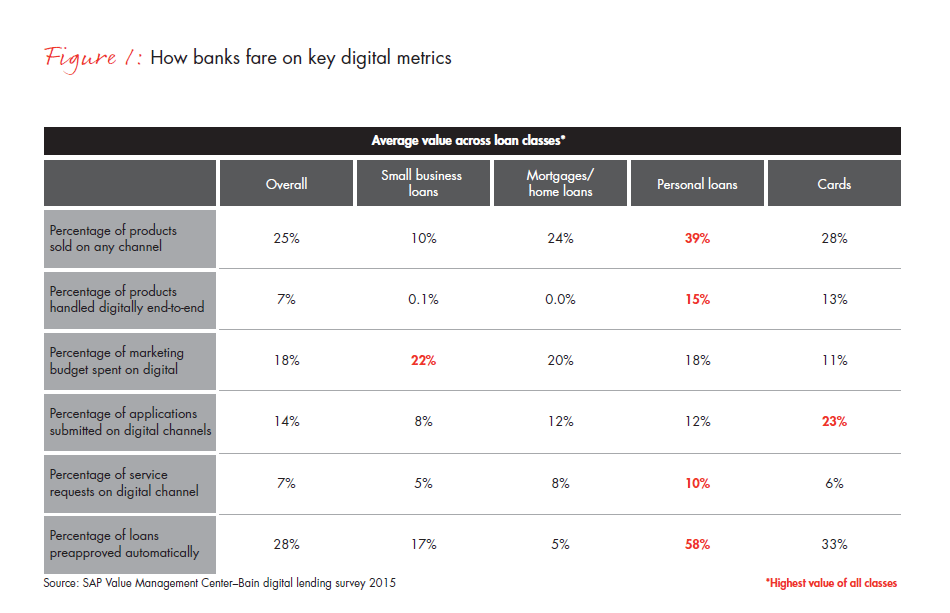
- On average, banks can handle only 7% of products digitally end-to-end.
- Customers submit only 14% of loan applications through digital channels.
- Most banks lack digital cross-selling expertise, with the average number of loans at just 1.1.
- Banks spend only 18% of their marketing budget on digital initiatives.
- 14% of simple loans and 36% of complex loans require rework.
- All of the above translates to mediocre combined annual growth in loans, at 3% for 2011 through 2014, and flows through to cost-efficiency metrics (see Figure 2).
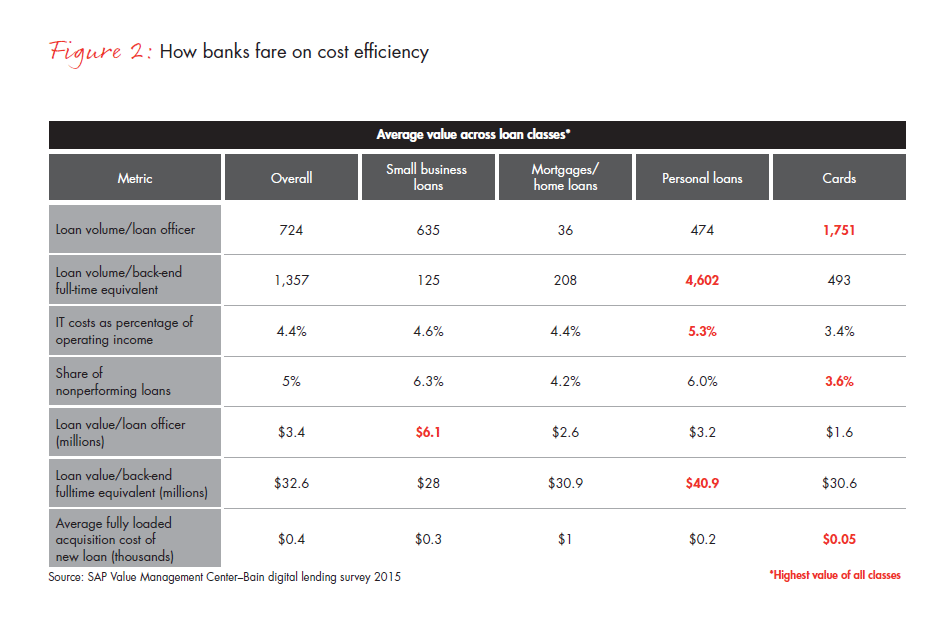
Across all countries, most banks’ capabilities fall far short of their own aspirations (see Figure 3). A score of 5 in digital maturity represents the emerging digital innovators, and even the current best-in-class banks have significant gaps to close. They’ve made more progress in simple lending product classes, such as personal loans and credit cards, than in complex product classes, such as mortgages and small business loans. Within banks as well, the survey finds a high variance between lending classes.
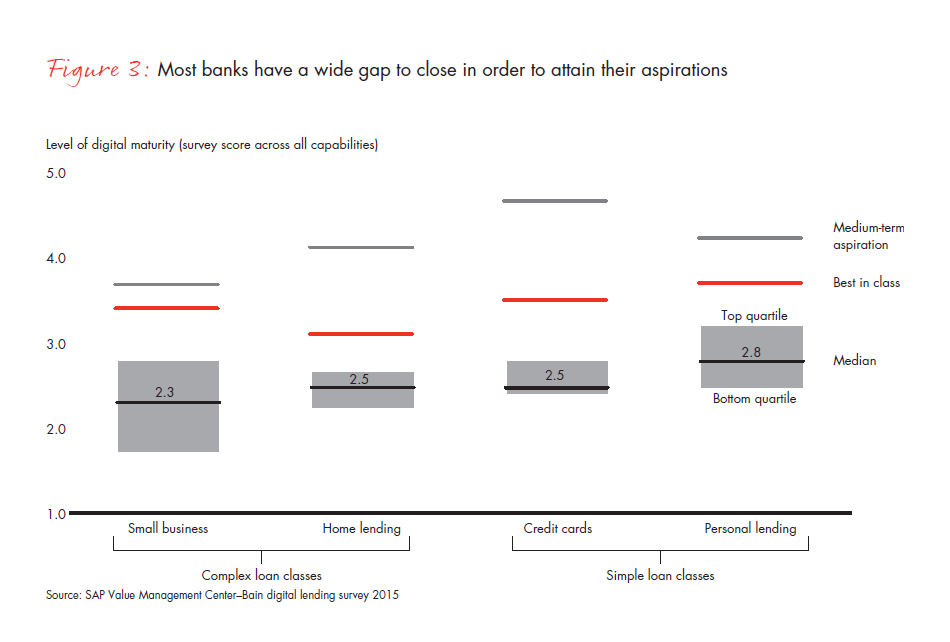
The survey reveals where banks face the greatest capability gaps (see Figure 4):
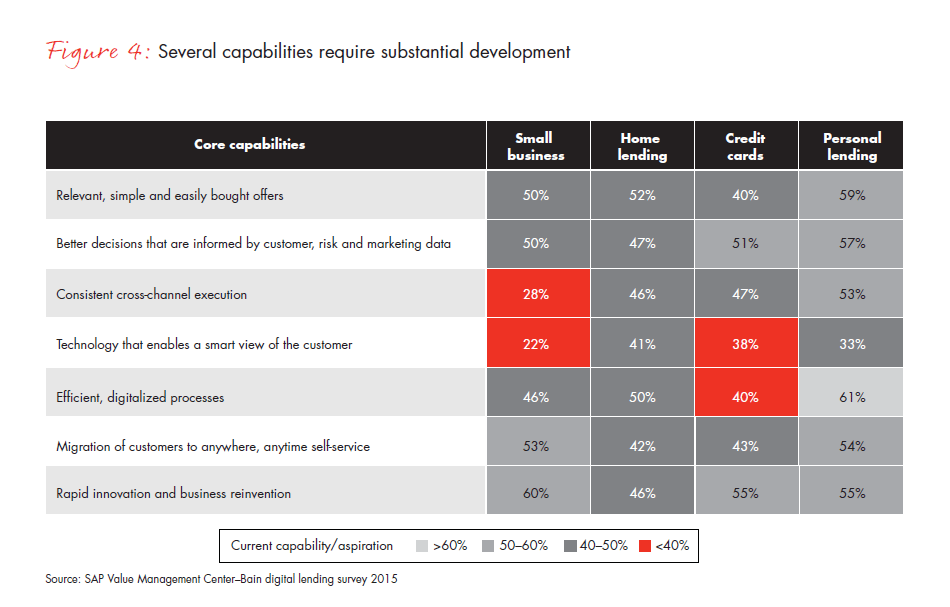
Delivering simple, easy and convenient experiences. At most banks, the lending process remains opaque to those who apply, making it difficult for customers to check the progress of an application or for the bank to provide updates through online or mobile channels. Customers struggle to find and select the product that incorporates the appropriate features for their needs without speaking with a bank agent. Few banks report having good digital tools to support employees during this process. In some cases, it’s even difficult to ensure critical milestones such as making mortgage funds available on the closing date.
Executing consistently across channels. Customers expect each channel to dovetail seamlessly with others so that they don’t repeatedly have to fill in the same data. Yet the behavior endemic at many traditional banks— strong departments that narrowly focus on improvements within their domain—undermines a cross-channel approach. The walls between departments and functions must come down.
Gathering a full and consistent picture of the customer for marketing, sales and service. Most banks report that they fall short in using the available internal and external data to make fast, high-quality decisions when lending money, identifying financial distress or collecting payments. In an era of data proliferation, greater computer power and digitally enabled customers, this represents a critical weakness of bank lenders.
Configuring base products and processes quickly and easily. Most banks have scores or even hundreds of product variations hard-coded into their information systems. Additional variations of features and benefits can extend into the thousands. This makes it difficult to present products easily and quickly to customers.
Digital marketing. Most banks have barely scratched the surface in learning how digital marketing and communications can effectively engage customers. While some have invested in workflow and automation tools, the promise of these technologies has yet to reach their potential in lending.
Straight-through processing. Most banks have no straight-through processing of loan applications for other than the simplest cases.
Shaping and accelerating the next wave of investment
When the banks in our benchmark survey have invested to digitalize lending, they have been rewarded by faster, better and less costly lending processes (see Figure 5). To realize even greater benefits and raise the returns on investments, the experiences of leading banks and companies in other industries suggest several principles to guide investments.
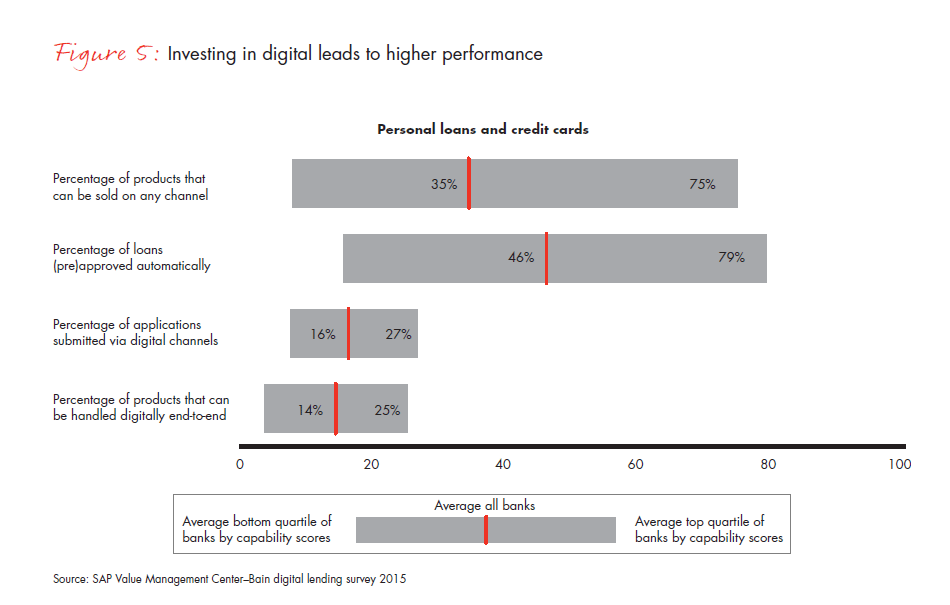
Design around the customer’s priorities, not for internal operations. When it comes to digital initiatives, banks often rely too much on an operational perspective based on internal metrics. While such initiatives might initially improve process efficiency, they also tend to undercut the customer experience by making it a secondary issue. For example, people don’t want to buy a mortgage, they want to access capital in order to buy a home. So they embrace an experience designed to help them buy a home more readily than one designed to sell them a mortgage.
Commonwealth Bank of Australia (CBA) and Hana Bank have been pioneers in this area. The digital components of their home-buying experience include using a smartphone’s location services to “point and shoot” properties and view details, making an appointment with a lender from the phone, calculating limits and receiving preapproval via an app, and using a mobile wallet to pay a deposit.
Similarly, Fidor Bank in Germany created a bank from scratch that focused entirely on the relationship with the customer. The bank’s motto, “banking with friends,” relates to the community of like-minded users who engage through social media platforms to offer advice and trade stories about all types of financial matters. Without the legacy of branches, Fidor offers a broad range of Internet and mobile banking services that includes peer-to-peer lending and emergency payday loans handled in a minute, thanks to straight-through processing.
Human judgment and advice still matter, of course, and the point is to equip customer-facing employees with digital tools that allow them to enhance the customer experience around their needs (buying a home, financing a business, funding an education). While the contact center remains a principal mechanism to support customers, it should also be easy for a customer to digitally schedule an appointment to see someone in a branch if they want advice or when regulatory requirements demand a face-to-face meeting.
Given the ascent of mobile banking, banks should increasingly take a mobile-first design approach, which imposes a useful reductionary discipline to the design of the entire experience. Mobile-first design forces banks to ask customers only for information the bank does not already have to make it easy to get advice, to limit the number of wet signatures, to reduce the number of pages of documentation and ultimately to eliminate paper. At mBank in Poland, users can access basic financial information on their phone without needing to log in, and they can obtain one-click loans with 30-second approval and disbursement. The mobile-first approach also can inform any redesign of the branch network and the contact center with video, chat, messaging and call capabilities to provide easy access to advice during the lending process.
Simplify products and processes. At the heart of most bank lending organizations are powerful product teams that typically aim to satisfy all possible customer demands with a huge array of product variations, price points and promotions. Product and process complexity has crept in through historical decisions taken in sequence. Similar products thus often have different processes that were implemented at different times in different ways.
To complicate matters, the chain of process steps, from inquiry to collecting customer details to codifying collateral to funding a loan, often functions through separate organizational departments. Some banks even make customers use separate mobile apps for their primary banking accounts and credit cards.
Improving the experience and lowering costs require winnowing down the product suite and replacing the complexity of 20 or 30 systems with just a couple of platforms that can handle variety, similar to how automakers have moved to platform sharing (chassis and powertrains) for a variety of car models. CBA, for instance, went from 610 product variants to 18 core products, which helped the bank reduce time to market by 75% and processing errors by 30%.
Banks can realize huge gains in operational efficiency by automating more manual processes, using workflow management tools and underwriting algorithms that spit out decision and approval. They can also use digital tools to raise employee productivity. A mortgage specialist can talk to many more people per day through video chat than in the branch or driving to customers’ locations. ABN AMRO in the Netherlands, for instance, has been able to use webcams to sell an increasingly large share of its mortgages.
Reboot the technology infrastructure to support great experiences. IT systems at traditional banks generally have hard-coded rules around every product feature, such as interest rate structure, term length, up-front fees and so on. And different departments might install their own coding, which means that a change-of-address request at a contact center would have different verification criteria than a request at the branch. The rigidity of hard coding does not allow banks to quickly develop or modify products digitally.
A more effective alternative that’s increasingly being adopted by digitally savvy companies is an IT engine that builds the basic features (interest rates, term, fees) into a core lending platform and then abstracts above that platform to accommodate any product. Product abstraction allows teams to more easily redesign and tinker with a product experience and have it sit on the underlying platform.
Companies in the digital vanguard have also moved away from individual IT systems that support product and functional silos to common systems across products, departments and functions. Key components that such systems deliver include the following:
- modular products that can be assembled like LEGO bricks, enabling fast time to market, a high degree of personalization for customers, and reuse through common processes and systems;
- customer profiles that result from merging traditionally structured transactional data with unstructured data from sources such as social media and customer e-mails; and
- the ability to deliver offers in real time that respond to the customer’s location, profile, preferences and past interactions.
Accelerate speed to market. While some banks can get to market in less than four months, many larger banks tend to take much longer. What accounts for the difference? In many cases, the leaders have replaced waterfall development of software and related systems (a sequential approach) with Agile development (incremental and modular), which typically moves more quickly and accommodates changes more readily.
Besides adopting Agile, some banks have looked outside to spark a change in their legacy organizations and pick up the pace of innovation. They’re finding that a partnership or acquisition is the most promising route to access the necessary talent and systems.
Regions, for instance, recently chose the partnership route with online lender Fundation to provide small businesses with a coordinated delivery of lending solutions. The two companies believe that each will benefit by combining Regions’ brand and retail distribution franchise with Fundation’s streamlined online loan application process and concierge service.
SunTrust, by contrast, bought online consumer lender FirstAgain outright in 2012. It relaunched the business as the LightStream online direct lending division making personal, unsecured loans. Loan decisions are made by human underwriters, but the process is accelerated by LightStream’s lending platform.
Fidor, the German online bank, demonstrates another way to access external talent. It was one of the first banks to provide application programming interfaces for third parties to integrate new applications. This gives software developers and fintechs the opportunity to present their products on a bigger stage, and it gives customers access to a growing set of banking services.
Investing to change the bank
Banks already spend a lot on IT—about 6% of 2014 revenue on average, Gartner estimates, far higher than the 1% to 4% in most other industries, including tech-intensive telecommunications. Will digital investments pile on that spending?
In the short run, yes, but the way that banks direct their investments will determine the payoff from digital. Banks making greater digital progress in lending operations have higher IT spend than average. The critical factor: They spend much more on changing the bank’s model than on running the existing model. Laggards do just the opposite (see Figure 6).
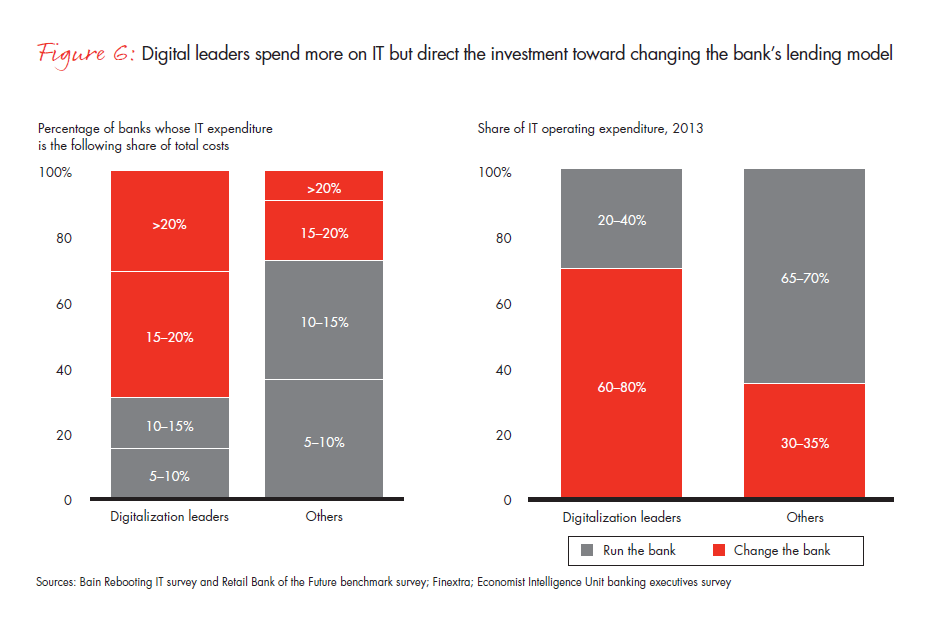
The leaders accept a higher IT cost because they’re automating more, reducing labor costs and setting the stage for higher revenue through digital conversions. They’re working to pay for the investment by removing errors and rework from the branch and call center and migrating more basic transactions to digital self-service channels.
Banks have no choice but to move quickly to digitalize their lending operations. Customers’ rising expectations for anytime, anywhere banking currently outrun banks’ capabilities. And fintechs have momentum in building a base of customers, especially among young adults, as well as in attracting talent. But even traditional banks can compete effectively in digital lending if they’re willing to put the customer’s priorities at the center of their digital redesign.
Richard Fleming and Joe Fielding are partners with Bain & Company’s Financial Services practice. They are both based in New York.
The authors thank Bernard Kenny, vice president at SAP, for his contributions to this brief and SAP Value Management Center more broadly for its collaboration in designing, hosting and executing the survey. Together, Bain and SAP Value Management Center use this benchmarking database to help retail banks gauge the digital potential of their businesses.





